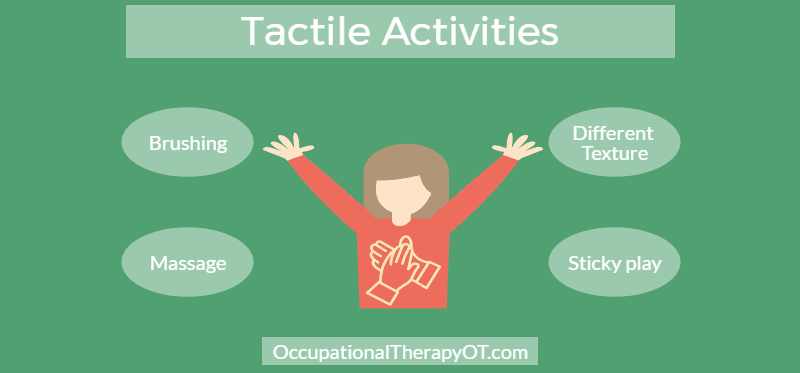Sensory Tactile Activities –
Tactile activities can be an important part of sensory diet or fine motor skill building program. Tactile activities are very helpful in problems like hand and finger awareness, attention, and fine motor planning.
What is a tactile system?
The tactile system provides us with our sense of touch. The sense of touch is important for growth and development, as well as survival.
The tactile system receives information about touch from receptor cells in the skin. The receptors are all over the bodies, providing information about light touch, vibration, pressure, temperature, and pain.
The Tactile system provides us information which is required for every activity of daily life it includes, eating, toileting, dressing, combing, household chores, school works, and job works.
Tactile Dysfunction-
Like vestibular dysfunction, the child with tactile dysfunction also has hyper or hypo-sensitive to touch or may have problems with tactile discrimination. Some children may excessively or under register the touch input. They may have a problem with tactile sensory modulation. It may create a problem in daily routine life.
- Tactile defensiveness-
In tactile defensiveness, the child may interpret and react harmless light touch as being potentially dangerous. These children may appear anxious, aggressive, unwilling to participate in home and school activities.
- Hypo responsive to touch-
Some kids may have hypo-responsive to the touch input. They may have a low arousal level and may not register some of the touch stimuli. This poor response to touch input may hamper the activities of daily living. Body awareness and motor planning may be disturbed.
- Touch seeker-
Some children seem to seek out excessive amounts of touch sensations. They crave for the touch sensation. They try to touch everything around.
The tactile system is very important for the development of other skills like gross motor skills and fine motor skills. Sensory tactile activities may be used to improve the modulation of tactile sensation.
CHARACTERISTICS OF TACTILE DYSFUNCTION–
The child who is over responsive to touch stimuli may:
- Rubbing off kisses or casual touches and pushing others away to avoid closeness.
- Instantly and intensely exhibit a “fight or flight” response or a “flight or freeze” response to harmless touch sensations.
- Dislike messy activities (cooking, painting, using chalk or tape).
- Be bothered by certain types of clothing, and be particularly sensitive to sock seams, shoes, and tags in shirts.
- Avoids some foods (rice, chunky peanut butter, lumpy mashed potatoes, vegetables) because of texture.
- Dislike swimming, bathing, brushing teeth, or having a hair cut.
The child who is under responsive to touch sensations may:
- Seem unaware of touch unless it is intense, showing little reaction to pain, and getting hurt without realizing it.
- Not realizing he/she has dropped something.
- Have poor body awareness.
- Disregard, whether clothes are on straight or face is messy.
- Physically hurt other people or pets, not comprehending their pain.
The child who seeks extra touch sensations may:
- Touch objects and people constantly, with “in your face” behavior.
- Seek certain messy experiences, often for long durations.
- Rub or bite own skin; twirl hair in fingers; prefer being barefoot.
- Chew on inedible objects (fingernails, collars, cuffs, toys, pencils).
Tactile activities-

Tactile activities under the sensory integration therapy by the occupational therapist help the child to modulate the tactile sensation.
Tactile activities include –
- Wilbarger protocol for sensory defensiveness. Provides deep pressure to the skin on the arms, back, and legs through the use of the special surgical brush.
- Brushing – Brushing on body parts like hand or legs with crayons or chalk and then erasing with various textures.
- Massage – body massage with lotions.
- Tactile box – which may include cornmeal, oatmeal, water, sand, different types of textured items, etc.
- Treasure Hunt – hide small objects in play Doh or to the tactile box to find with fingers.
- Painting- outdoor with water, paint roller in bathtub, soap crayons.
- Shaving Cream – to draw or blow
- Tactile box to collect small items and different textures to match and sort.
- Face and body paints, temporary tattoos or stickers.
- Blindfold games- pin the tail on the donkey.
- Daily access to dry sensory play materials (e.g. rice, sand, or beans)
- Toys hidden in the sensory play materials.
- “High fives” throughout the day.
- Drawing in sand or salt.
- Therapy tubing, therapy putty, balloons or rubber gloves filled with things like corn, flour, rice, etc.
- Wheelbarrow walking over various surfaces.
Generally, the proprioceptive activities, tactile activities, and vestibular activities may be used in the sensory integration therapy. for the kids with ADHD and Autism.
References-
- Smith, Sinclair A., et al. “Effects of sensory integration intervention on self-stimulating and self-injurious behaviors.” American Journal of Occupational Therapy4 (2005): 418-425.
- Yack, Ellen, Shirley Sutton, and Paula Aquilla. Building bridges through sensory integration. Future Horizons, 2003.
- Kranowitz, Carol Stock. The out-of-sync child: Recognizing and coping with sensory processing disorder. Penguin, 2005.
- Larkey, Sue. Practical sensory programmes for students with autism spectrum disorders. Jessica Kingsley Publishers, 2007.






love this article. Helps my PE teachers plan a student’s APE IEP! thanks so much.
Dear Payal ans Deepam
I had been working as a Early childhood Educator since 18 years and i have done my maters in Psychology too. And our Waldorf system also address all lower senses of a child. When i went through your work it feels me so amazed the way you describe very difficult stuff in a very simple way. It is really amazing.
Regards
Very understandable! Thank you very much Maam/Sir!